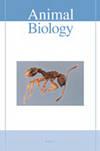Fatty acids for insect species remain constant: A case study of pink bollworm, Pectinophora gossypiella (Saunders)
IF 0.9
4区 生物学
Q2 ZOOLOGY
引用次数: 0
Abstract
Pink bollworm, Pectinophora gossypiella (Saunders) originates from South Asia and has spread across major cotton-growing regions. The pest is considered to be the most destructive and of economic concern across the globe. In India, the pest has developed resistance to dual Bt toxins and its concealed feeding nature makes the target sites almost inaccessible for the insecticide. In view of this issue, there is need to identify a suitable alternative for its management. In this context, semiochemicals serve as one of the best eco-friendly options. These chemical substances or mixtures broadcast messages for the purpose of communication. Semiochemicals may be released from eggs, faecal pellets, tarsal segments, scales, anal tufts and/or any insect components that reduce the intra/interspecific competition for shared resources such as food, mating, oviposition site etc. Accurate identification of the semiochemical compounds and their proportion in natural blends that arouse a strong behavioural response in insects, requires a thorough knowledge. Therefore in the present study, we tried to explore the chemicals present in eggs, faecal pellets and whole-body wash extracts of mated female. Seven compounds were identified from a methanolic extract of faecal-pellet samples, namely hexadecanoic acid, 9,12-octadecadienoic acid, 9-octadecenoic acid and their methyl esters along with methyl stearate. However, only four methyl-esterified forms were found in common in eggs and female body wash extract. This clearly shows that the compounds remain constant and conserved for the species but the role of these compounds needs to be demonstrated.昆虫种类的脂肪酸保持不变:以粉棉铃虫Pectinophora gossypiella (Saunders)为例
粉红色棉铃虫,Pectinophora gossypiella (Saunders)起源于南亚,并已蔓延到主要的棉花种植区。这种害虫被认为是全球最具破坏性和经济问题的害虫。在印度,这种害虫已经对双Bt毒素产生了耐药性,而且它隐蔽的取食性质使得杀虫剂几乎无法进入目标地点。鉴于这一问题,有必要为其管理确定一个合适的替代办法。在这种情况下,半化学物质是最好的环保选择之一。这些化学物质或混合物以传播信息为目的。卵、粪丸、跗节、鳞片、肛丛和/或任何昆虫成分可能释放出半化学物质,从而减少种内/种间对共享资源(如食物、交配、产卵地点等)的竞争。要准确识别引起昆虫强烈行为反应的符号化合物及其在天然混合物中的比例,需要全面的知识。因此,在本研究中,我们试图探索存在于卵,粪丸和全身洗液提取物的雌性交配。从粪丸甲醇提取物中鉴定出7种化合物,分别为十六烷酸、9,12-十八烯酸、9-十八烯酸及其甲酯和硬脂酸甲酯。然而,在鸡蛋和女性沐浴露提取物中只发现了四种常见的甲基酯化形式。这清楚地表明,这些化合物在物种中保持恒定和保守,但这些化合物的作用需要证明。
本文章由计算机程序翻译,如有差异,请以英文原文为准。
求助全文
约1分钟内获得全文
求助全文
来源期刊

Animal Biology
生物-动物学
CiteScore
2.10
自引率
0.00%
发文量
34
审稿时长
3 months
期刊介绍:
Animal Biology publishes high quality papers and focuses on integration of the various disciplines within the broad field of zoology. These disciplines include behaviour, developmental biology, ecology, endocrinology, evolutionary biology, genomics, morphology, neurobiology, physiology, systematics and theoretical biology. Purely descriptive papers will not be considered for publication.
Animal Biology is the official journal of the Royal Dutch Zoological Society since its foundation in 1872. The journal was initially called Archives Néerlandaises de Zoologie, which was changed in 1952 to Netherlands Journal of Zoology, the current name was established in 2003.
 求助内容:
求助内容: 应助结果提醒方式:
应助结果提醒方式:


